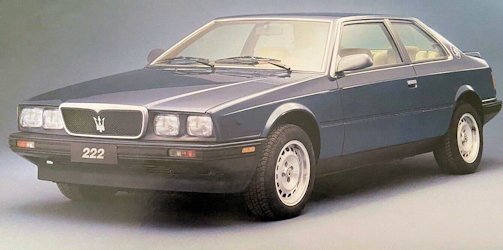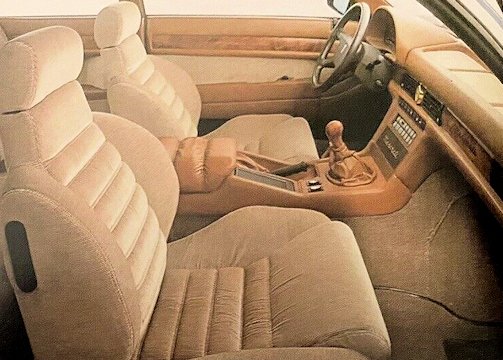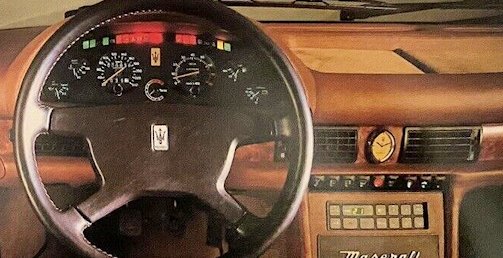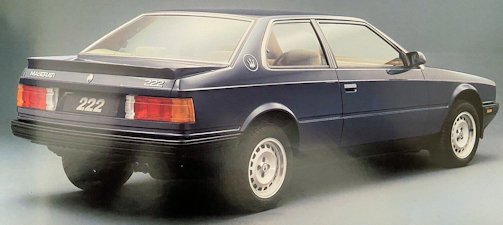Maserati 222
 |
|
|
Production period: |
1988 to 1990 |
|
Class: |
sports car |
|
Body versions: |
Coupe |
|
Engines: |
Gasoline: 2.0 litres |
|
Length: |
4043 mm |
|
Width: |
1714 mm |
|
Height: |
1305 mm |
|
Wheelbase: |
2514 mm |
|
Curb weight: |
1172 kg |
The Maserati 222 is a two-door coupe made by the Italian carmaker Maserati, manufactured only from 1988 to 1990.
History
In 1988 a restyling by the designer Marcello Gandini revolutionized the range. All versions adopted a softer front end, new bumpers, different rims, new interiors with changes to the dashboard, seats, door panels and significantly improved finishes. The engines were revised or new: the base was the 1996 cm³ biturbo V6 with three injection valves per cylinder and 223 HP, which powered the Biturbo 222 (coupé), Biturbo 422 (sedans)
This replaced the produced since 1981 of the original Biturbo. The 222 was equipped with a 2.0-liter six-cylinder engine, which had a gasoline injection and two turbochargers. This was destined for the home Italian market only. The 222 is not to be confused with the 222 E, which was externally identical, but as export version was equipped with the larger 2.8-liter engine of the 228.
Particular care is been reserved for ride comfort with the introduction of a new system of German acoustic insulation to complete the already built
noise and vibration barrier. Long journeys, even at speed high, are thus traveled in total tranquility, allowing one careful, safe and non-fatiguing driving. The interiors are set up according to the best Maserati tradition: a immediate sensation of richness, quality, sporty elegance as soon as you enter the passenger compartment: nothing is left to chance; The materials: seats in soft velvet (on request in leather) even more anatomical in shape, they were designed after careful ergonomic studies to offer perfect lateral sealing; the adjustment of the backrest of the front seats and electrically operated. The door panels, the side panels and the the dashboard has leather trim embellished. The climate control system with programmed temperature and locking are standard
centralized doors. The luggage compartment lid, fully lined in stain-resistant carpet, it opens electrically with a button placed on the dashboard.
The now classic Maserati watch is now equipped with integral lighting. The gear knob, anatomically shaped for a better grip.

The Italian tax legislation had opposed a wider use of the Maserati models, the cars with a displacement of 2000 cc and more, with a sales tax of 38 percent, while taxed vehicles with a smaller displacement only 19 percent. With the biturbo Maserati circumvented this problem by the car received a just 2.0-liter six-cylinder engine, which was equipped for the purpose of performance with two turbochargers. In the original version, this engine produced 132 kW. Together with a largely automated production opened the Biturbo, which could be manufactured significantly cheaper than the previous Maserati models. Maserati for model year 1988 undertook minor stylistic changes, the company to make all future models account for the name Biturbo. The successor to the Biturbo I was given the number code 222.

With its introduction the 222 took over the role of the basic model in Maserati's Italian program. Shortly after the regular 222 appeared a more powerful version with the name 2.24 v. It was equipped with a revised 2.0-liter engine, which had four valves per cylinder. The 2.24 v replaced the previous sports version Biturbo Si. The production of the 222 was discontinued in 1990 the 2.24 v, which remained until 1993 in the program. The four-door version of the 222 received the designation 422. It replaced the previous Biturbo 420.Improved performance: 220hp, over 225km/h, 6.2 seconds from O to 100 km/h, 26.3 seconds to cover the kilometer from standstill.
Performance:
- 222
164kW (220hp) [223PS) at 6250rpm
82.2kW/L (110.1hp/L)
[111.8PS/Ll; 262Nm (193.41bft) at 5000rpm - 2.24V
4 valves per cylinder, total 24
180kW (241hp) [245PS] at 6200rpm,
90.1kWL (120.7hp/L)
122.6PS/L1; 296Nm (218.41bft) at 5000rpm.
The engine was in its basic form as the original twin-turbo from 1981. It was a six-cylinder V-engine with a cylinder bank angle of 90 degrees. The displacement was 1996 cm³ (bore × stroke = 82 × 63 mm). Each cylinder bank had an overhead camshaft, both camshafts were driven by a common timing belt. Each cylinder had two intake valves and one exhaust valve. The 222 took over the technical specifications of the previous sports model Biturbo Si. With an electronic gasoline injection from Magneti Marelli and two turbochargers from IHI, each with a water-air cooler. The compression ratio was 7.8: 1. The engine provided 162 kW, just like in the Biturbo Si.
The body of the Maserati 222 was self-supporting. It corresponded stylistically and, in the structure, largely of the original and had only been revised in some details. The modifications went back to Marcello Gandini. In particular, the front end was now designed rounder, and the radiator grille was smaller than its predecessor In addition to improving the coefficient New exterior rear-view mirrors, particularly cared for in shape to avoid annoying turbulence at high speed. On the boot lid was a standard rear spoiler A button, located on the armrest of the driver's side door, allows to electrically adjust the position of both.The rear spoiler, extensively tested on previous models,increases the dynamic load on the driving wheels to better unload the power and adds an even sportier note to this Maserati coupé. They concerned the basic 2.0-liter version as well as the export version 222 E.
The chassis of the 222 also corresponded in its basic design of the original biturbo. With all round independent suspension, in front there was MacPherson struts and wishbones, rear was trailing arm used. In addition, came telescopic shock absorbers front and rear.
As with the previous model, Maserati made the engines themselves. The body, on the other hand, was built by Innocenti in Lambrate near Milan, a company belonging to the De Tomaso Group.
In three years built, 1156 copies of the 222 were made.

Technical
-
Maserati 222 Technical details and specifications (1988-1990)
ENGINE:
6-cylinder in V 90deg
Engine capacity: 1996cm3
bore and stroke: 82 x 63mm
compression ratio 7.8:1
light-alloy cylinder
head and cylinder block
wet cylinder liners
4 bearing crankshaft
oil capacity 7L (6.6US qt)
electronic fuel injection.
2 IHI turbochargers
boost pressure 0.5bar
charge-air cooler.
TRANSMISSION DRIVE LINE:
drive rear wheels
5-speed manual, final drive ratio 3.73.
ZF-automatic 3 HP—22, hydraulic torque converter and 3-speed Planetary gear set
Gear ratios: 5—speed manual; 1st 3.42; 2nd 2.08/1.94; 3rd 1.39; 4th 1; 5th 0.87/0.79; R 3.66.
Automatic: ZF 3 HP—22, max torque multiplication in converter 2.28 times,
Planetary gear set
Gear ratios Automatic: 1st 2.478; 2nd 1.478. 3rd 1; R 2.09.
central selector lever
final drive ratio 3.31
Optional Torsen limited slip differential.CHASSIS:
Integral body with front McPherson struts, lower control arms with tension struts and antiroll bar
rear independent suspension with semi—trailing arms, optional antiroll bar, front and rear coil springs and telescopic dampers.BRAKES:
power assisted brakes
discs front (also ventilated) and rear; mechanical
handbrake to rear wheelsSTEERING:
rack and pinion steering
optional power assisted
turning circle 11.7mELECTRICAL EQUIPMENT:
Battery 12V 60Ah
alternator 65A
cooling system capacity 12L (11.4US qt).DIMENSIONS AND WEIGHT:
Wheelbase 260cm
Length 440cm
width 173cm
height 131cm.
track 144/145cm, 7 J 145.5/146cm
gross vehicle weight approx 1730kg
kerbweight (DIN) 1255kg© Motor car History
Service
-
Maserati 222 Service Guide (1988-1990)
Firing order.1-6-2-5-3-4 (cylinder 1 is the first on the right-handside)
Spark plugs Champion N6YC NGK BP.8ES
Spark plugs electrode gap 0.7-0.8 mm
Valve clearance (cold engine)
• Intake. 0.35 ± 0.04 mm
• Exhaust 0.45 ± 0.04 mm
ignition Advanced electronic before 12°±1 TDC at 1,000 r.p.m.)
fuel leaded premium grade.
fuel tank 80/8214 (17.6/18Gal) [21.1/21.7US Gall
tyres 205/55 VR 14, 205/55 VR 15, or 205/50 VR 15
wheels 6.5 or 7J.
load space 19.4cu ft (550dm3)© Motor car History
